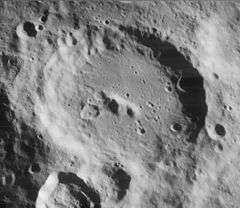Vlacq (crater)
Vlacq is a prominent lunar impact crater that is located in the southeastern part of the Moon, and appears foreshortened when viewed from the Earth. This crater is adjacent to the northeastern rim of the larger Hommel, and to the northwest rim of Rosenberger.
 Lunar Orbiter 4 image | |
| Coordinates | 53.3°S 38.8°E |
|---|---|
| Diameter | 89 km |
| Depth | 3.0 km |
| Colongitude | 323° at sunrise |
| Eponym | Adriaan Vlacq |
This crater has become eroded, but not to the degree of the larger neighboring craters. The satellite crater Vlacq G intrudes into the southern rim of Vlacq, and is overlaid in turn along the southwest rim by the sharp-rimmed Vlacq B. The satellite crater Vlacq C is attached to the northeastern exterior rim of Vlacq.
The interior floor of Vlacq has been resurfaced by lava, leaving a nearly level base. The southwest half of the floor, however, is overlaid by ejecta from nearby impacts. In the midpoint of the floor is a rounded massif that is about 15 kilometers in length, being long along the northwest direction. The floor contains a number of tiny craterlets as well as several ghostly crater remnants in the western half. The most notable of these is a circular depression to the west of the central peak.
Satellite craters
By convention these features are identified on lunar maps by placing the letter on the side of the crater midpoint that is closest to Vlacq.
| Vlacq | Latitude | Longitude | Diameter |
|---|---|---|---|
| A | 51.2° S | 38.9° E | 17 km |
| B | 51.0° S | 39.7° E | 18 km |
| C | 50.3° S | 39.4° E | 19 km |
| D | 48.7° S | 36.2° E | 34 km |
| E | 52.0° S | 36.2° E | 11 km |
| G | 54.9° S | 38.1° E | 27 km |
| H | 47.9° S | 34.9° E | 11 km |
| K | 51.2° S | 36.6° E | 12 km |
References
- Andersson, L. E.; Whitaker, E. A. (1982). NASA Catalogue of Lunar Nomenclature. NASA RP-1097.CS1 maint: ref=harv (link)
- Blue, Jennifer (July 25, 2007). "Gazetteer of Planetary Nomenclature". USGS. Retrieved 2007-08-05.CS1 maint: ref=harv (link)
- Bussey, B.; Spudis, P. (2004). The Clementine Atlas of the Moon. New York: Cambridge University Press. ISBN 978-0-521-81528-4.CS1 maint: ref=harv (link)
- Cocks, Elijah E.; Cocks, Josiah C. (1995). Who's Who on the Moon: A Biographical Dictionary of Lunar Nomenclature. Tudor Publishers. ISBN 978-0-936389-27-1.CS1 maint: ref=harv (link)
- McDowell, Jonathan (July 15, 2007). "Lunar Nomenclature". Jonathan's Space Report. Retrieved 2007-10-24.CS1 maint: ref=harv (link)
- Menzel, D. H.; Minnaert, M.; Levin, B.; Dollfus, A.; Bell, B. (1971). "Report on Lunar Nomenclature by the Working Group of Commission 17 of the IAU". Space Science Reviews. 12 (2): 136–186. Bibcode:1971SSRv...12..136M. doi:10.1007/BF00171763.CS1 maint: ref=harv (link)
- Moore, Patrick (2001). On the Moon. Sterling Publishing Co. ISBN 978-0-304-35469-6.CS1 maint: ref=harv (link)
- Price, Fred W. (1988). The Moon Observer's Handbook. Cambridge University Press. ISBN 978-0-521-33500-3.CS1 maint: ref=harv (link)
- Rükl, Antonín (1990). Atlas of the Moon. Kalmbach Books. ISBN 978-0-913135-17-4.CS1 maint: ref=harv (link)
- Webb, Rev. T. W. (1962). Celestial Objects for Common Telescopes (6th revised ed.). Dover. ISBN 978-0-486-20917-3.CS1 maint: ref=harv (link)
- Whitaker, Ewen A. (1999). Mapping and Naming the Moon. Cambridge University Press. ISBN 978-0-521-62248-6.CS1 maint: ref=harv (link)
- Wlasuk, Peter T. (2000). Observing the Moon. Springer. ISBN 978-1-85233-193-1.CS1 maint: ref=harv (link)